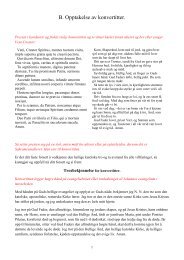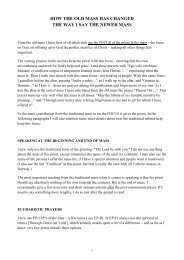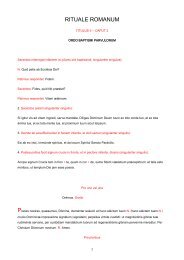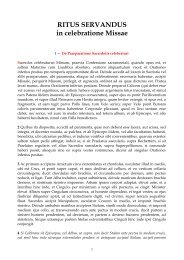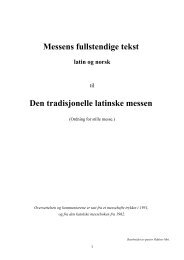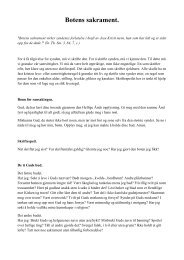oppgaven finner man i sin helhet her
oppgaven finner man i sin helhet her
oppgaven finner man i sin helhet her
Create successful ePaper yourself
Turn your PDF publications into a flip-book with our unique Google optimized e-Paper software.
ikke kunne erstatte liturgiens fastsatte tekster. Slik blir sakral musikk klassifisert <strong>her</strong>:<br />
"4. 'Sacred music' includes the following: a) Gregorian chant; b) sacred polyphony; c)<br />
modern sacred music; d) sacred organ music; e) hymns; and f) religious music.<br />
5. Gregorian chant, which is used in liturgical ceremonies, is the sacred music proper to<br />
the Ro<strong>man</strong> Church; it is to be found in the liturgical books approved by the Holy See. This<br />
music has been reverently, and faithfully fostered, and developed from most ancient, and<br />
venerable traditions; and even in recent times new chants have been composed in the<br />
style of this tradition. This style of music has no need of organ or ot<strong>her</strong> instrumental<br />
accompaniment.<br />
6. Sacred polyphony is measured music which arose from the tradition of Gregorian<br />
chant. It is choral music written in <strong>man</strong>y voice-parts, and sung without instrumental<br />
accompaniment. It began to flourish in the Latin Church in the Middle Ages, and reached<br />
its height in the art of Giovanni Pierluigi Palestrina (1524-1594) in the latter half of the<br />
sixteenth century; distinguished musicians of our time still cultivate this art.<br />
7. Modern sacred music is likewise sung in <strong>man</strong>y voice-parts, but at times with<br />
instrumental accompaniment. Its composition is of more recent date, and in a more<br />
advanced style, developed from the previous centuries. When this music is composed<br />
specifically for liturgical use it must be animated by a spirit of devotion, and piety; only on<br />
this condition can it be admitted as suitable accompaniment for these services.<br />
8. Sacred music for organ is music composed for the organ alone. Ever <strong>sin</strong>ce the pipe<br />
organ came into use this music has been widely cultivated by famous masters of the art. If<br />
such music complies with the laws for sacred music, it is an important contribution to the<br />
beauty of the sacred liturgy.<br />
9. Hymns are songs which spontaneously arise from the religious impulses with which<br />
<strong>man</strong>kind has been endowed by its Creator. Thus they are universally sung among all<br />
peoples. This music had a fine effect on the lives of the faithful, imbuing both their private,<br />
and social lives with a true Christian spirit (cf. Eph 5:18-20; Col 3:16). It was encouraged<br />
from the earliest times, and in our day it is still to be recommended for fostering the piety<br />
of the faithful, and enhancing their private devotions. Even such music can, at times, be<br />
admitted to liturgical ceremonies (Musicæ sacræ disciplina, Dec. 25, 1955; AAS 48 [1956]<br />
13-14).<br />
10. Religious music is any music which, eit<strong>her</strong> by the intention of the composer or by the<br />
subject or purpose of the composition, serves to arouse devotion, and religious<br />
sentiments. Such music 'is an effective aid to religion' (Musicæ sacræ disciplina, idem.). But<br />
<strong>sin</strong>ce it was not intended for divine worship, and was composed in a free style, it is not to<br />
be used during liturgical ceremonies."<br />
Dette blir gjentatt i paragraf 20:<br />
"Religious music then absolutely must not be admitted into any liturgical function. (…)"<br />
De Musica Sacra ser på “religiøs musikk” som en form for underholdning, selv om den<br />
erkjenner at denne typen musikk kan være gunstig for katolikker utenom liturgien:<br />
“55. The proper places for religious music compositions are in concert halls, or in the<br />
assemblies of congress, but not in churches intended for the worship of God.”<br />
18<br />
18




